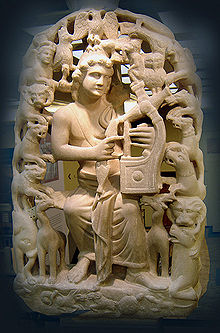
A folk dance is developed by people that reflect the life of the people of a certain country or region. Not all ethnic dances are folk dances. For example, ritual dances or dances of ritual origin are not considered to be folk dances. Ritual dances are usually called "Religious dances" because of their purpose. The terms "ethnic" and "traditional" are used when it is required to emphasize the cultural roots of the dance. In this sense, nearly all folk dances are ethnic ones. If some dances, such as polka, cross ethnic boundaries and even cross the boundary between "folk" and "ballroom dance", ethnic differences are often considerable enough to mention.

The music of Greece is as diverse and celebrated as its history. Greek music separates into two parts: Greek traditional music and Byzantine music, with more eastern sounds. These compositions have existed for millennia: they originated in the Byzantine period and Greek antiquity; there is a continuous development which appears in the language, the rhythm, the structure and the melody. Music is a significant aspect of Hellenic culture, both within Greece and in the diaspora.

Circle dance, or chain dance, is a style of dance done in a circle or semicircle to musical accompaniment, such as rhythm instruments and singing. Circle dancing is probably the oldest known dance formation and was part of community life from when people first started to dance.

Antikristos or Antikrystós is a dance of Greek origin. “Aντικρυστός” in Greek language refers to the verb αντικρύζω “be across, opposite, face-to-face”. It is also known in Armenia. Antikristos, has similarities with karsilamas dance. It is danced in couples.

Kochari (Armenian: Քոչարի, is an Armenian folk dance.

Sousta is the name of a folk dance in Cyprus and Crete which is danced in Greece and generally in the Balkans. The music is generally played with a lyre, laouto, and mandolin.
The Tsamikos or Kleftikos is a popular traditional folk dance of Greece, done to music of 3/4 meter.

Greek folk music includes a variety of Greek styles played by ethnic Greeks in Greece, Cyprus, Australia, the United States and elsewhere. Apart from the common music found all-around Greece, there are distinct types of folk music, sometimes related to the history or simply the taste of the specific places.
Turkish folk dances are the folk dances of Turkey. Facing three seas, straddling important trade routes, Turkey has a complex, sophisticated culture, reflected in the variety of its dances. The dominant dance forms are types of line dance. There are many different types of folk dances performed in various ways in Turkey, and these reflect the cultural structure of each region. The Bar in Erzurum province, the Halay in the East and Southeast, the Hora in Thrace, the Horon in the Black Sea, Spoon dances in and around Konya and Lezginka in Kars and Ardahan are the best known examples of these.

Horon (Greek) or khoron, refers to a group of a circle folk dances from the Black Sea region of Turkey.

The Dance of Zalongo refers to the mass suicide of women from Souli and their children during the Souliote War at December 16, 1803. After being trapped by Ottoman Albanian troops, near the village of Zalongo in Epirus, modern Greece, then Ottoman Empire, c. 22 women decided to turn towards the cliff's edge together with their infants and children rather than surrender. According to tradition they did this one after the other while dancing and singing. The name also refers a number of Greek theatrical dramas and a song in folk style, commemorating the event, named "Dance of Zalongo". There is also a similar Cham Albanian dance-song called Vallja e Zallongut.
Lerikos is a traditional Greek circle dance. Participants hold hands at the shoulder level and dance in a counterclockwise direction.
Tamzara is an Armenian, Assyrian, Azerbaijani, and Greek folk dance native to Anatolia. The name is derived from a former Armenian village located in the region of Şebinkarahisar. This dance was especially popular in the regions of Erzincan, Erzurum, Kigi, Arapgir, Harput, and Malatya. There are many versions of Tamzara, with slightly different music and steps, coming from the various regions and old villages in Anatolia.

Nisiotika is the name of the songs and dances of Greek islands including a variety of Greek styles, played by ethnic Greeks in Greece, Cyprus, Australia, the United States and elsewhere.

Antipatitis is a form of a Greek folk dance from Greek island Karpathos, Greece.

The Palamakia is a Greek folk dance from Zagorochoria and Tzoumerka in Greece. It is based on syrtos and the movements of the legs and arms.

Mandilatos is a Greek folk dance from Thrace, in 2+2+3 7
16 and 7
8 pattern. Mandilatos is a couples' dance that takes its name from the mandilia that are held while performing it. Mandilatos is often performed in Thrace and the Black Sea Region during wedding processions.There are similar folkloric dance tunes known as Laz bar in Armenia.









